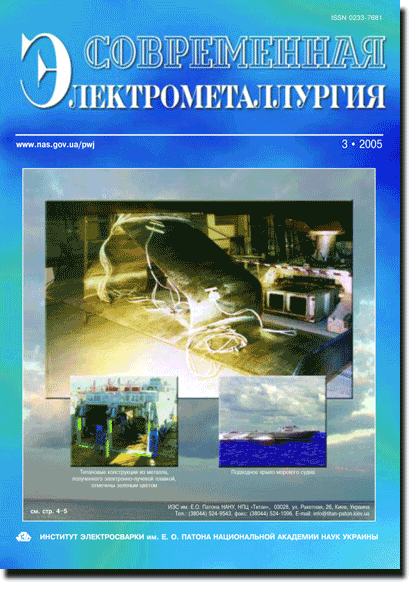

Paton B.E. Current achievements of the E.O. Paton Electric Welding Institute in the field of welding and related processes 2
ELECTROSLAG TECHNOLOGY
Medovar L.B., Saenko V.Ya., Remizov A.G. and Yarosh V.M. Peculiarities of structure of bimetal reinforcement bar with a corrosion-resistant clad layer of steel 316L 18
Peculiar features of bimetal reinforcement bar of 16 mm diameter with a corrosion-resistant clad layer of steel 316L, rolled from 350 mm diameter billet after cladding using the ESR LM method, are described. Results of macro- and microexaminations of the zone of joining the base and cladding layer are given and distribution of chemical elements in the joining zone is studied.
Eryomin E.N. and Zherebtsov S.N. Electroslag chill mould casting of solid horn-shaped cores 21
New technology is proposed for production of solid horn-shaped cores, including electroslag melting of consumable electrode in melting crucible, modifying of molten metal by refractory particles and its subsequent pouring together with slag into chill mould. Equipment for realizing this process is described. Results of comparative analysis of cast metal are given and advantages of the technology are shown.
ELECTRON BEAM PROCESSES
Zhuk G.V., Berezos V.A. and Trigub N.P. Prediction of structure of titanium ingots-slabs produced by EBCHM method 26
Data of mathematical calculations of parameters of crystallization are given: gradients of temperature, rates of melt cooling for ingots-slabs of titanium alloy TiД6AlД4V of EBCHM. Charts of ingots crystallization are obtained on the basis of cooling rates. The correlation of predicted structure with structure of real ingots-slabs is shown.
Akhonin S.V., Milenin A.S. and Pikulin A.N. Simulation of evaporation processes of alloying elements during electron beam surface melting of ingots-slabs from titanium-base alloys 29
Mathematical model of evaporation of alloying elements in electron beam surface melting of ingots-slabs from titanium-base alloys has been developed. Dependencies of chemical composition of melted metal of ingot on technological parameters of the process were obtained as a result of surface melting of TiД6AlД4V alloy ingots-slabs.
Makhotkin A.V., Malashenko I.S. and Topal V.I. Separation processes during electron beam evaporation of alloys and mixtures of substances 33
Gas-dynamic aspects of electron beam evaporation are considered. Effect of space separation of vapor components of different molecular mass was revealed and investigated, the principle of which consists in condensate enrichment with a component of large molecular mass in the center of the vapor flow, while at the flow periphery Е with a component of smaller molecular mass. Results of experiments on evaporation of different alloys are presented. A method of isotopes separation has been offered on the basis of the revealed effect.
Varich I.Yu., Akhonin S.V. and Trigub N.P. Utilization of tantalum scrap by means of electron beam melting 40
Results of experimental investigations for utilization of different types of tantalum scrap by means of electron beam melting are presented. Optimized technology for producing quality ingots-slabs at maximum yield of efficient metal was developed. It is shown that the electron beam surface melting of tantalum ingots-slabs allows their rolling into strip without intermediate forging operation.
VACUUM-ARC REMELTING
Zhadkevich M.L., Telin V.V., Teslevich S.M., Lesnoj A.B., Demchenko V.F. and Shapovalov V.A. Crucible thermal work optimization during vacuum-arc skull melting 43
Numerical simulation of heat exchange processes proceeding under the conditions of vacuum-arc skull melting was made. Dependence of maximum pouring out of molten metal on geometric parameters was analyzed.
GENERAL PROBLEMS OF METALLURGY
Kritsky V.E., Burylyov B.P. and Kritskaya E.B. Electric conductivity of fluoride and chloride mixture melts 47
Relation was obtained between values of specific electric conductivity of fluorides and appropriate chlorides, from which the deduction of unknown characteristics of electric conductivity of fluorides of meal of iron group is possible. Equation is offered, describing the concentration dependence of specific electric conductivity of alkali-earth fluoride-chloride melts of mixtures. Prediction of dependences of electric conductivity on composition for systems MnF2ДMnCl2 and CoP2ДCoCl2 etc. is possible.
ENERGY AND RESOURCE SAVING
Paton B.E., Chernets A.V., Marinsky G.S., Korzhik V.N. and Petrov V.S. Prospects of using plasma technologies for disposal and recycling of medical and other hazardous waste. Part 1 49
Problems connected with disposal and recycling of medical and other hazardous waste are analyzed. Existing ways of their solution, among which the application of plasma technologies is most effective, are considered. Examples of application of different technologies and equipment of plasma recycling of waste prove their significant advantage as compared to canonic technologies, in particular using combustion. It is shown that the new processes allow complex solution of the problems of recycling and disposal of waste (both from the point of view of high efficiency and environmental safety) and can be recommended as one of he most promising alternative ways of improvement and development of technologies for recycling medical and other hazardous waste.
Zhadkevich M.L., Shapovalov V.A., Konstantinov V.S., Stepanenko V.V., Torkhov G.F., Burnashev V.R., Rejda N.V. and Kolesnichenko V.I. Production of consumable electrodes by titanium sponge compaction under current 58
Analysis of technological charts of pressed billet manufacture from non-compact charge for subsequent remelting is briefly described. Prospects and economic advisability of non-compact charge pressing by combination of the electric heating processes and minor pressing forces without using powerful and expensive press equipment are shown. Design of a pilot installation and functional technological charts of non-compact charge pressing and main technological parameters of the process are described.
INFORMATION
Thesis for a scientific degree 62
(You are viewing the simplified file contents)
The cost of subscription/purchase order journals or individual articles
| Journal/Currency | Annual Set | 1 issue printed |
1 issue |
one article |
| TPWJ/USD | 384 $ | 32 $ | 26 $ | 13 $ |
| TPWJ/EUR | 348 € | 29 € | 24 € | 12 € |
| TPWJ/UAH | 7200 UAH | 600 UAH | 600 UAH | 280 UAH |
| AS/UAH | 1800 UAH | 300 UAH | 300 UAH | 150 UAH |
| AS/USD | 192 $ | 32 $ | 26 $ | 13 $ |
| AS/EUR | 180 € | 30 € | 25 € | 12 € |
| SEM/UAH | 1200 UAH | 300 UAH | 300 UAH | 150 UAH |
| SEM/USD | 128 $ | 32 $ | 26 $ | 13 $ |
| SEM/EUR | 120 € | 30 € | 25 € | 12 € |
| TDNK/UAH | 1200 UAH | 300 UAH | 300 UAH | 150 UAH |
| TDNK/USD | 128 $ | 32 $ | 26 $ | 13 $ |
| TDNK/EUR | 120 € | 30 € | 25 € | 15 € |
AS = «Automatic Welding» - 6 issues per year;
TPWJ = «PATON WELDING JOURNAL» - 12 issues per year;
SEM = «Electrometallurgy Today» - 4 issues per year;
TDNK = «Technical Diagnostics and Non-Destructive Testing» - 4 issues per year.





